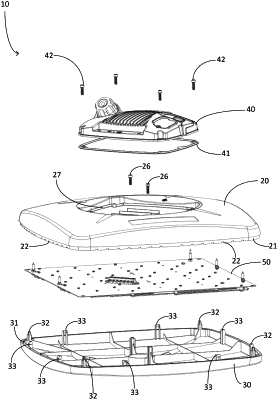| CPC H01Q 1/42 (2013.01) [H01Q 1/12 (2013.01)] | 23 Claims |

|
1. A method for manufacturing an antenna, comprising:
providing a monocoque front housing-half having a peripheral edge;
providing a monocoque rear housing-half having a peripheral edge and configured to mate with the monocoque front housing-half in forming a radome with a hollow interior for an antenna arrangement, wherein the monocoque front housing-half peripheral edge is shaped to define a channel configured to receive the monocoque rear housing-half peripheral edge;
positioning an antenna panel on an inner surface of either the monocoque front housing-half or the monocoque rear housing-half;
applying a curable adhesive sealant substance within the monocoque front housing-half peripheral channel;
aligning the monocoque rear housing-half with the monocoque front housing-half such that the monocoque rear housing-half peripheral edge coincides with the monocoque front housing-half peripheral channel during a process of mating the monocoque front housing-half and the monocoque rear housing-half;
moving the monocoque front housing-half and the monocoque rear housing-half towards each other thereby at least partially submerging the monocoque rear housing-half peripheral edge in the curable adhesive sealant substance received in the monocoque front housing-half peripheral channel to form a waterproof seal and adhesively bond the monocoque front housing-half and the monocoque rear housing-half to each other once the curable adhesive sealant substance has cured; and
fully closing the radome following mating of the monocoque front housing-half and the monocoque rear housing-half by causing at least one first clip engagement member of and within the monocoque front housing-half to mechanically engage with at least one corresponding second clip engagement member of and within the monocoque rear housing-half, thereby mechanically securing the monocoque front housing-half and the monocoque rear housing-half to each other in addition to adhesive bonding provided by the cured curable adhesive sealant substance.
|